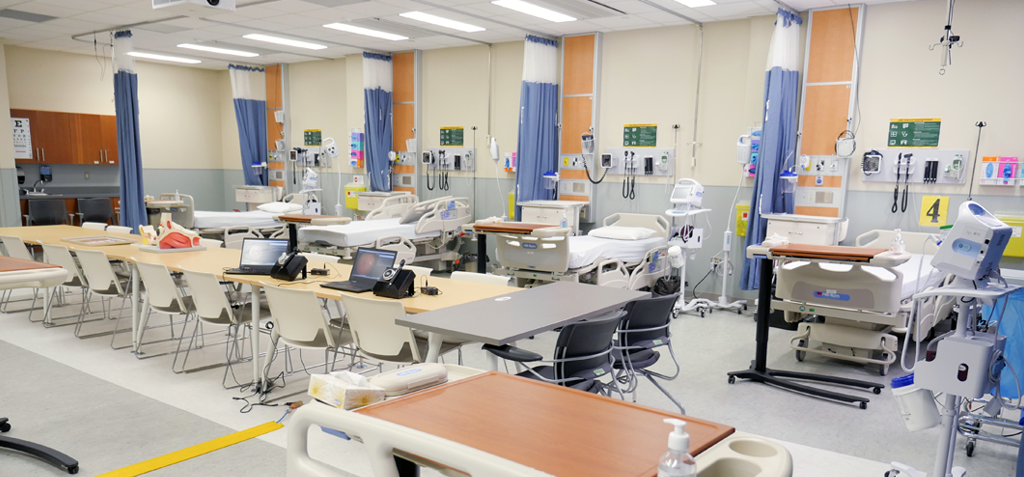Simulation plays an important role in the education of health science students and healthcare professionals. The University of Saskatchewan Clinical Learning Resource Centre (USask CLRC) manages a simulated healthcare facility that provides specialized learning environments and a variety of simulation equipment for students to practice and learn clinical skills in a supervised, controlled, and virtual environment. Clinical learning and practice opportunities at the CLRC are supported by the computerized manikins, procedural task trainers, and medical-grade equipment comprising the CLRC’s significant pool of training resources.
From engaging with participants from the Simulated Patient (SP) Program and the Learner Practice Program to practicing on state-of-the-art equipment or accessing simulation practice guidelines and other documentation — USask health science learners and educators rely upon the CLRC to deliver transformative teaching and learning experiences as well as a number of essential competency assessments.
Simulation Facilities
Learning and practicing in simulated real-life environments enhances health science learner confidence and the ability to safely treat patients. Thanks to CLRC facilities housed within various locations of the USask Health Sciences Building, learners are able to utilize the full spectrum of simulation modalities available today. Learners can practice on high-fidelity simulation equipment, procedural task trainers, standardized patients, and volunteer actor patients — either with or without instructor supervision. The CLRC is a robust facility that supports the continuously developing educational needs of health science learners.
The CLRC hosts approximately 2,000 events encompassing approximately 75,000 learner contact hours every year. This support includes undergraduate and postgraduate groups, research teams, student groups, professional licensing boards, and other health care partners. These events encompass the full spectrum of simulation based learning modalities.
All CLRC spaces are extremely flexible and can be converted to simulated spaces to support multiple health science programs.
Explore the sections below to learn more about the specialized simulation spaces available at the University of Saskatchewan Clinical Learning Resource Centre.

Four procedure labs with a total of 28 beds are available for various USask health science programs to develop acute care skills, procedural skills, and clinical reasoning and decision-making skills. These rooms can simulate nursing wards, postop recovery rooms, emergency wards, physiotherapy labs, and several other professional spaces.
Location: Rooms 2231, 2235, 2239, and 2249
The CLRC features 23 clinic rooms outfitted with medical exam or physical therapy tables.
These spaces are primarily utilized as exam rooms for clinical skills assessment; however, they are frequently transformed into acute care spaces that facilitate clinical practices such as procedural skill development and scenario-based clinical reasoning.
Location: Rooms 2203-2228

Simulated real-life environments give students confidence in their ability to treat patients.
The CLRC offers health science learners a range of simulation tools, including three high-fidelity simulation labs which can be set up to mimic a number of different settings including an emergency room, a hospital ward, dental offices, and even a surgical suite.
Location: Rooms 2232-2234
Simulation Equipment
The CLRC maintains an extensive variety of simulation, task trainer, imaging and other equipment including, but not limited to:
- Cardiopulmonary simulator: Harvey
- High-fidelity adult simulators: SimMan 3G and SimMan Essential
- High-fidelity obstetrical simulator: Victoria
- High-fidelity pediatric simulators: Nena, SimBaby, newborn and 5-year-old Hal
- Features and complications of breathing, airway, cardiac and other systems
- Maternal and fetal monitors
- Patient monitors
- Patient voice
- Various task trainers to improve specific skills
To request an equipment loan from the CLRC, please complete the CLRC Equipment Loan Request Form.
To inquire about CLRC equipment inventory and its availability or use, please contact the CLRC.
Practice Guidelines & Information Resources
The Clinical Learning Resource Centre is deemed a laboratory space by University of Saskatchewan (USask) Safety Resources. In addition to maintaining a professional appearance in the CLRC, all faculty, staff, and students working/learning in USask laboratory environments must follow fundamental health and safety practices. Additional guidelines have been established to protect the supply and/or longevity of CLRC equipment and resources.
Violation of these guidelines will be reported to the appropriate faculty member and associate dean at the discretion of the CLRC.
Information resources
This video introduction to the CLRC is intended for health science learners and community partners who will be using the University of Saskatchewan Clinical Learning Resource Centre (USask CLRC) for learning and practicing clinical and communication skills in a safe, simulated environment.
Watch the video below to learn more about the CLRC's location, clinic room use, common supplies, procedure labs, and high-fidelity simulation suites.
The University of Saskatchewan is committed to providing a safe environment for all who work and study at our campuses. Information involving safety requirements and regulations, safety training, workplace/lab safety, environmental hazards, safety equipment, and more is accessible via the safety channel in PAWS.
The USask Health Sciences has developed several policies to support the management of the Health Sciences Building and to help expedite the number of diverse requests and inquiries regularly received from the university community.

